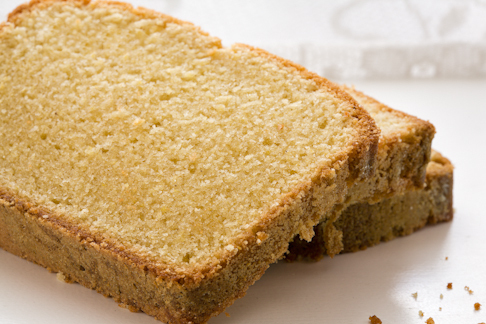Colonial Cornmeal Pound Cake

introduction
A quick perusal of colonial cookbook facsimiles such as The Carolina Housewife or The Virginia Housewife reveals that the housewives in question were not spartan or shy when it came to cake ingredients. Brandy, sherry, orange-flower water, and rose water were regularly added to cake batters already burdened with butter, eggs, and “new milk.” Indian meal (what we call cornmeal) might meet up with soft, new-crop pastry flour and a shower of freshly grated mace or nutmeg. Inevitably, when we read these old recipes, we become faint with hunger, and long to be seated in a beautiful parlour taking tea along with a slice or three of a superb, old-fashioned cake.
We have created—in the colonial tradition—a lush pound cake, moist and velvety with bolts of sweet creamed-corn flavor running through it. In Native American corn cookery, orange blossom is one of the nuance aromas; orange-flower water potentiates the corn flavor in this cake. Sherry is another nod to the colonial tradition, and a few drops of vanilla come along to make the other ingredients comfortable. Baked with a “lining” of fine cornmeal and sugar, this cake’s crust is particularly winsome—richly flavored and delicately crisp.
If only we had a parlour.
Baking Notes
We baked versions of this cake using Anson Mills Fine and Coarse Yellow Cornmeal. The results were not surprising: the cake made with the fine cornmeal had a finer texture; the cake made with the coarse cornmeal had bigger corn flavor. In other respects, they are interchangeable. You choose. It is best if all the ingredients for this recipe are at room temperature—including the flour and cornmeal—before you make the batter.
equipment mise en place
For this recipe, you will need a digital kitchen scale, a 9 by 5-inch loaf pan, a fine tea strainer, a small bowl, a 2-cup liquid measuring cup, a medium mixing bowl, a stand mixer fitted with the flat-beater attachment, a rubber spatula, a small offset spatula, and a wire rack.
-
-
8ounces (16 tablespoons) unsalted European-style butter, room temperature, plus additional for greasing the loaf pan
-
2.5ounces (½ cup) Anson Mills Fine Yellow Cornmeal or Coarse Yellow Cornmeal, plus 1 tablespoon for dusting the loaf pan
-
7ounces (1 cup) superfine sugar, plus 1 tablespoon for dusting the loaf pan
-
7.5ounces (1½ cups plus 1½ tablespoons) Anson Mills Colonial Style Fine Cloth-Bolted Pastry Flour
-
1teaspoon baking powder
-
Scant ½ teaspoon fine sea salt
-
4large eggs, room temperature
-
3tablespoons orange-flower water
-
2tablespoons Madeira or dry sherry
-
2tablespoons whole milk, room temperature
-
1teaspoon vanilla extract
-
-
Adjust an oven rack to the lower-middle position and heat the oven to 325 degrees. Generously butter a 9 by 5-inch loaf pan. Sift the 1 tablespoon cornmeal through a fine tea strainer into a small bowl. Discard the coarse particles in the strainer or return them to the bag of cornmeal. Add the 1 tablespoon sugar to the sifted cornmeal and stir to combine. Dust the buttered loaf pan with the cornmeal-sugar mixture, tilting to coat the bottom and sides, and then knock out the excess. Set the pan aside.
-
Turn the cornmeal, flour, baking powder, and salt into a medium mixing bowl and whisk to combine. Crack the eggs into a 2-cup liquid measuring cup. Add the orange-flower water, sherry, milk, and vanilla and beat lightly with a fork until combined.
-
Beat the butter in the bowl of a stand mixer fitted with the flat-beater attachment until light and fluffy, about 2 minutes. Scrape down the bowl with a rubber spatula. With the mixer running on medium-low speed, add the sugar, then increase the speed to medium-high and beat until the mixture is light and aerated, about 3 minutes, scraping down the bowl once or twice. With the mixer running on low speed, add the dry ingredients in three batches alternating with the egg mixture in two batches, beginning and ending with the dry ingredients and scraping down the bowl 2 or 3 times. When all of the ingredients have been incorporated, detach the bowl from the mixer and fold the batter lightly with the rubber spatula to ensure that no wet or dry pockets remain.
-
Scrape the batter into the prepared loaf pan and, using a small offset spatula, spread it to the sides and corners of the pan and smooth the surface. Bake, rotating the pan after 35 minutes, until the cake is deep golden brown, nicely risen, and a wooden skewer or toothpick inserted into the center comes out clean, about 1 hour and 10 minutes. Let the cake cool in the pan on a wire rack for 5 minutes. Invert the cake onto the rack, turn it right side up, and let cool to room temperature.